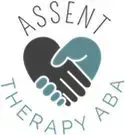What is Assent?

What is the most important thing to consider in an ABA company – Assent
When your child is diagnosed with Autism Spectrum Disorder (ASD), it is likely you’ve already dealt with so much. So many appointments. Long waitlists. Insurance companies (they are a beast in themselves), worry, anxiety, and every other emotion under the sun. Now, you are taking on the daunting task of figuring out what therapies are best for your child.
You might be considering occupational therapy (OT), physical therapy (PT), speech therapy, applied behavior analysis (ABA) therapy, etc. An overwhelming information overload.
If you are considering ABA therapy for your child, let me give you the most important question to ask the company/BCBA/provider/etc.
The most important question to ask your ABA provider…
How do you promote and honor assent in the clients/children you serve?
If they aren’t sure what you are asking, red flag.
If they avoid your question, run.
Why? What is Assent?
Assent is the process in which your child is empowered with the ability to decide if they want to participate in therapy services. This is a respectful process where the adult listens to your child’s communication, whether it be through body language, non-vocally (signs, picture exchanges, etc.), or vocally.
If your child says no, the adult stops therapy until the child agrees to continue.
Wait, are there providers out there who are NOT listening to the children? Yes.
Some will physically make your child comply by putting their hands on their body (physical management) or will repeatedly tell the child to complete the demand until they listen. This could go on for hours. Your child could spend hours with someone telling them to “stand up”. Another troublesome strategy is seclusion. It is often an overused strategy used in ABA. Closing a door to a room and waiting until a child is calm and ready to comply does not equal assent.

Important Notes :
Full disclosure here, there are situations where physical management is necessary. This would be a life-threatening situation such as they are running near a road with cars coming, threatening a suicide attempt with the ability or motivation to act, or a fire/tornado/etc. However, this should only last until the threat has been minimized. This happens when a child is back in a safe location, dangerous items have been removed from the child, etc.
Before we proceed, I do want to point out that obtaining assent from a child does not mean your child will not cry or be upset. However, it does mean that the BCBA needs to continue adjusting the session, looking at other factors (aka setting events) such as tiredness, if the child is hungry, cold, etc, and consider other ways we can change the environment to create realistic accommodations.
As we begin preparing your child for school, there are many situations that will require them to comply, such as listening to a teacher when they say, “Everybody line up” at the end of recess or be safe around peers. These are absolutely skills that need to be taught. There are many skills that your child will excel at and others that your child will struggle with. Cooperation might be one of those skills. Forcing it won’t teach the skill, especially without inflicting serious trauma/long-term harm. Teaching cooperation and assent go hand-in-hand, but we will expand on that topic another time.
We left off on the topic of forced compliance and not obtaining assent. One way that is done is by “physical management”.
An eye-opening article that outlines the extent at which physical restraints can be freely used in Indiana is below. I quoted some of the relevant sections; however, I encourage you to read the full article for yourself.
Sanctioned Violence: Restraint Use in Indiana Medicaid Waiver Settings
“A child with developmental disabilities can be put in a restraint hold without either his/her or parental consent.”
Wait, what?
Next, let’s consider this, “Restraints are traumatizing to not only the person being restrained but also to the person who is performing the intervention. ” Furthermore, “without any prior approval, a staff member may place a person with a developmental disability in a restraint using his or her personal judgment if a behavior the person exhibits is one that presents an imminent serious danger to themselves or others.”
However, there is no training on what this would like or what exactly is a behavior emergency. One could easily say that a behavior emergency is your child engaging in a behavior that does not have a plan in place.
So, we’ve got both parties engaging in traumatic activities without proper training or oversight?
Is this really happening to children, even the little ones? Yes. I’ve worked in environments with 3-6 years old who have been “physically managed” because they were not wanting to stand up or go where they were told to go. Imagine how traumatizing it would be to learn that your choices/words do not matter, and you do not have control over your body.
Okay, we could talk all day about this, but what do you do?
So, how do you make sure this is NOT your child?

You ask questions.
- If you have not seen your child’s behavior protocol or crisis management procedures, this is something that you can request. Best practice is for the BCBA to show you and have you agree to the changes every time that make a significant alteration to the document. You should fully understand the procedures and why they are implementing the approaches they are. If they are physically putting your child back into their chair, transporting them to another location because they aren’t listening, again, outside of emergencies like the building is literally on fire, this is likely unnecessary and traumatizing.
- Ask them what their crisis management procedures are. According to COMMISSION ON SECLUSION AND RESTRAINT IN SCHOOLS, Mandt and Crisis Prevention Institute (CPI) are the 2 most common methods used (Mandt was indirectly referred to in the sanctioned violence article referenced above.).
- Safety Care is also popular among ABA Providers. I am not familiar with Mandt, but I do know anyone trained and certified in CPI is taught how to physically retrain your child and transport. I am currently CPI trained. Again, there is justification for extreme, “building is on fire” emergencies.
- Safety Care is also popular among ABA Providers. I am not familiar with Mandt, but I do know anyone trained and certified in CPI is taught how to physically retrain your child and transport. I am currently CPI trained. Again, there is justification for extreme, “building is on fire” emergencies.
- Ask about antecedent interventions. Antecedent = before the behavior of interest happens. What is your child’s BCBA doing to intervene BEFORE anything even happens? Your child likely has many warning signs before they escalate to dangerous behaviors. What are the interventions in place when those warning signs are displayed? There should be some form of backing off. When your child pushes, the BCBA should not go to shove mentality. Power struggles are a whole other topic.
- How is my child being taught self-advocacy skills? Your child has the right to learn skills that benefit them, even if they make our job harder. They absolutely should be taught, “no”, “stop”, “I’m done”, etc. Any form of communication from AAC devices/picture icons/vocal language/etc. can learn these skills.
This means that the BCBA needs to get back to the drawing board and figure out how to attain the child’s assent before continuing. Simple as that.
If you are concerned and feel like your child’s assent is not being attained and honored, please feel free to reach out about your next steps.
Sanctioned Violence: Restraint Use in Indiana Medicaid Waiver Settings
(there are links to the relevant laws in the article):
More to read on this topic:
For more eye-opening, in-depth reviews, subscribe to my email newsletter.



